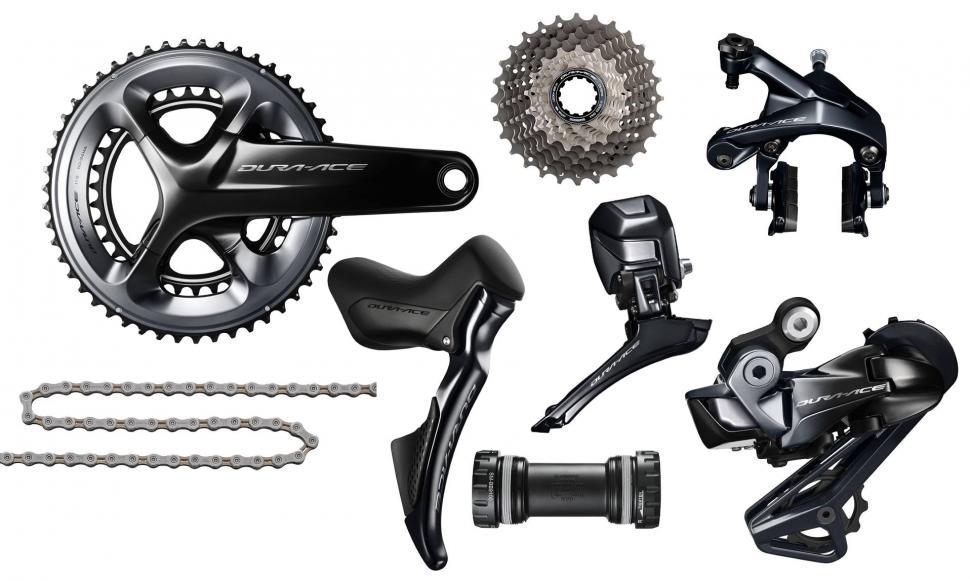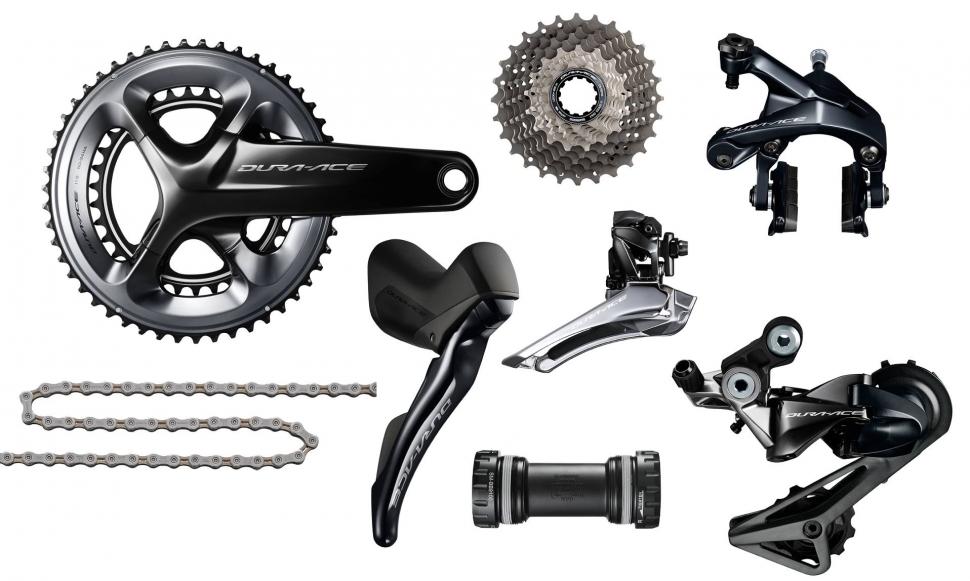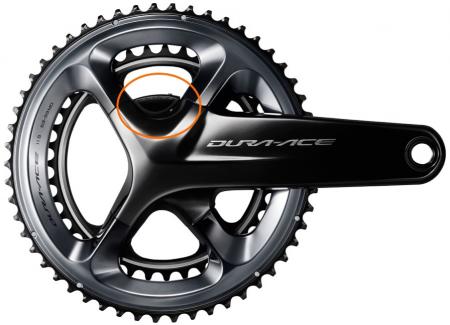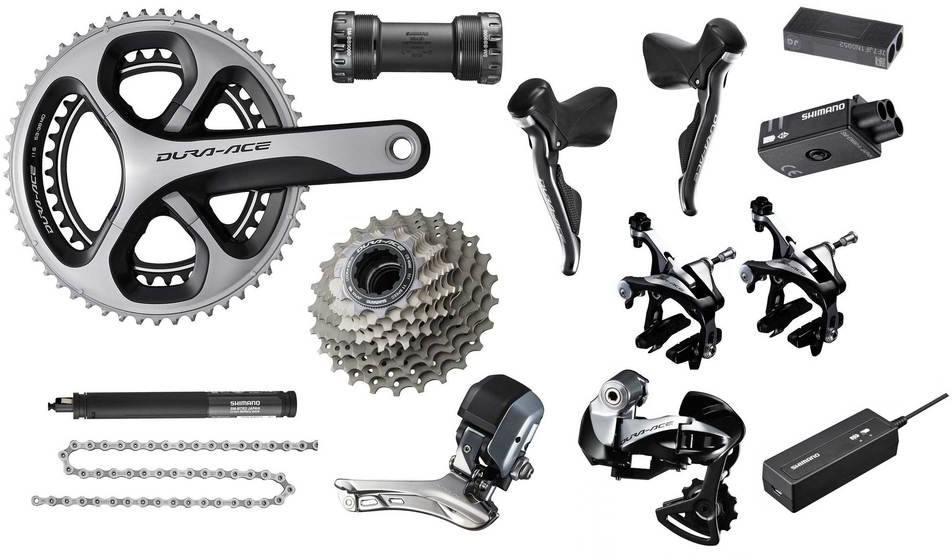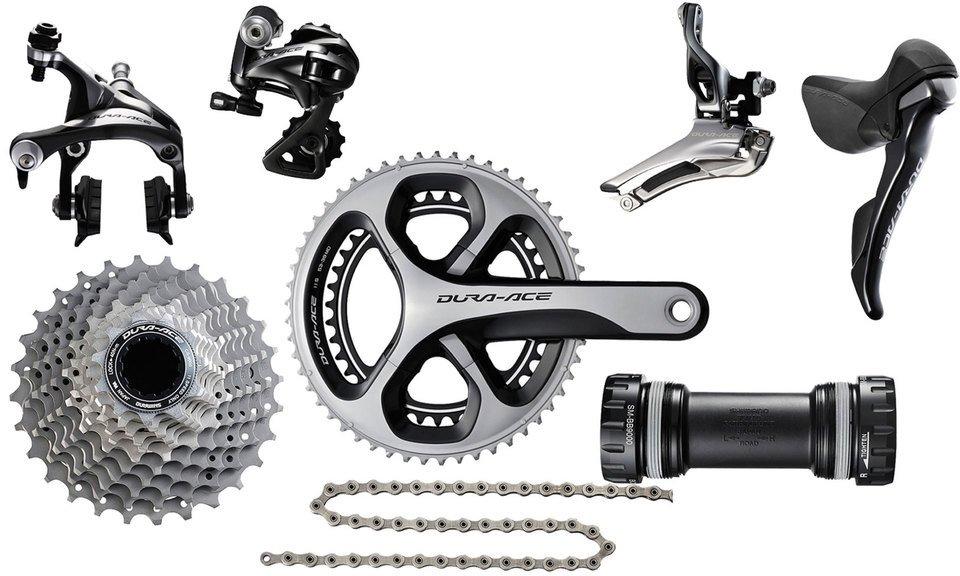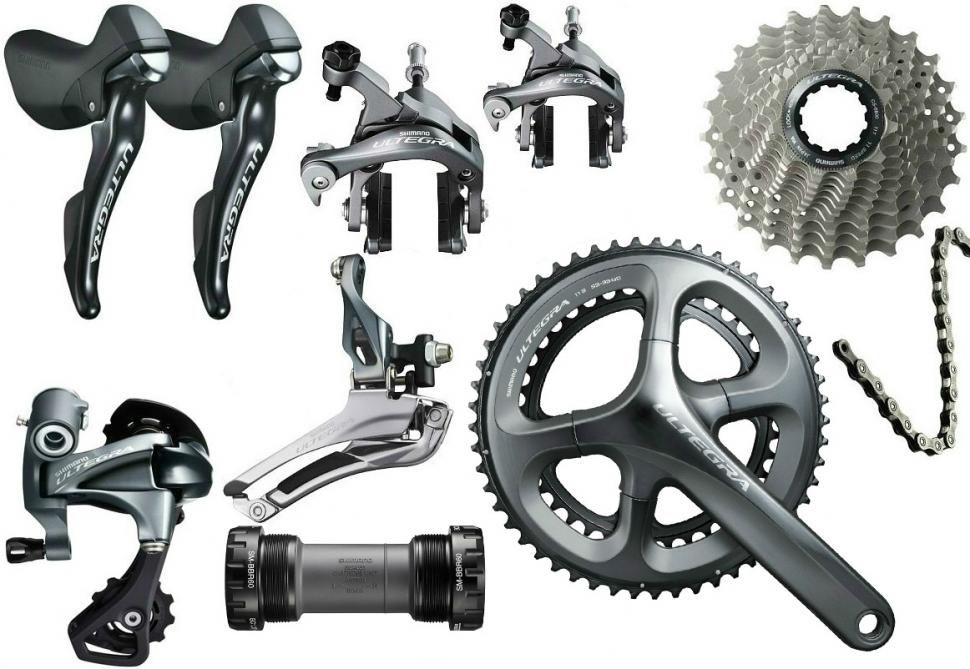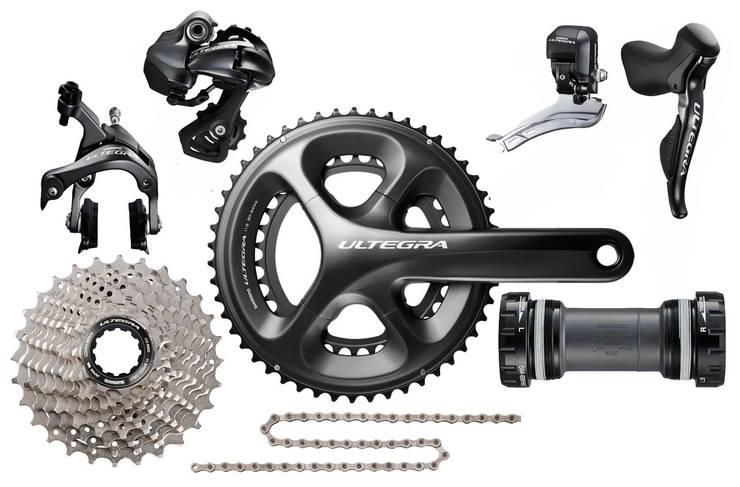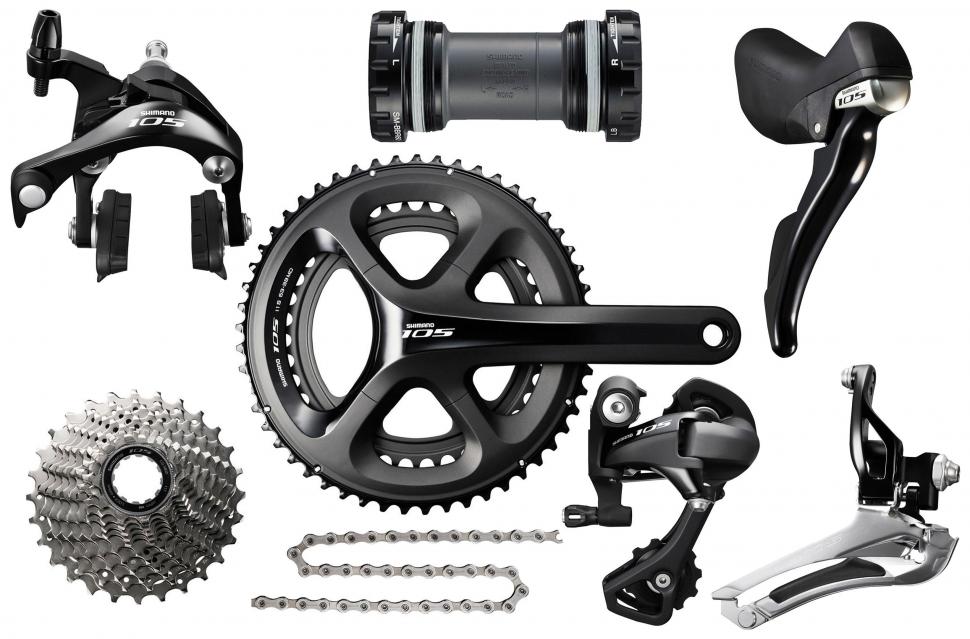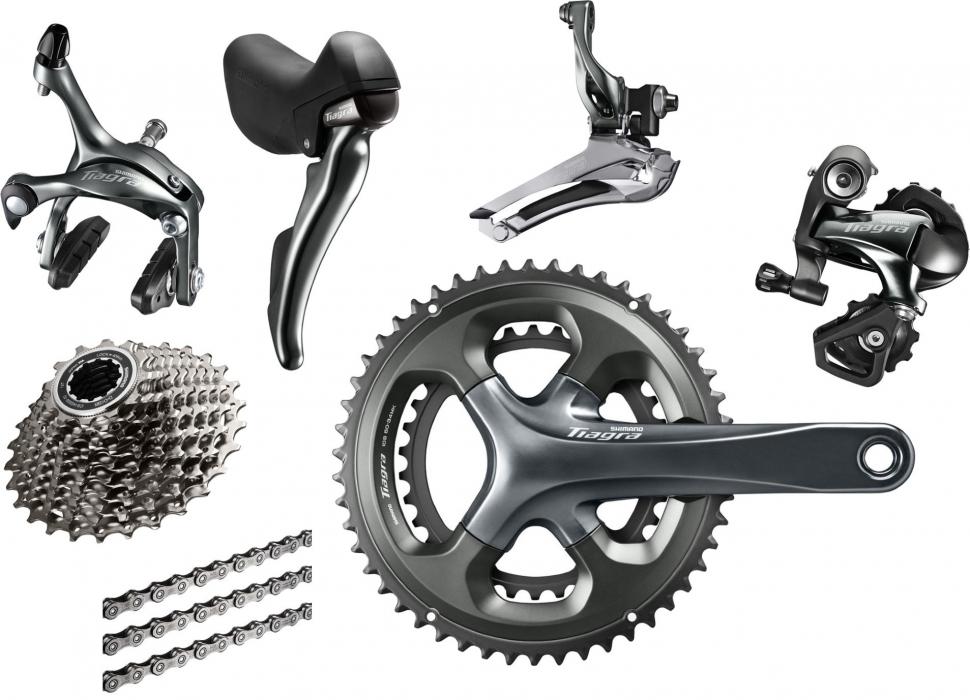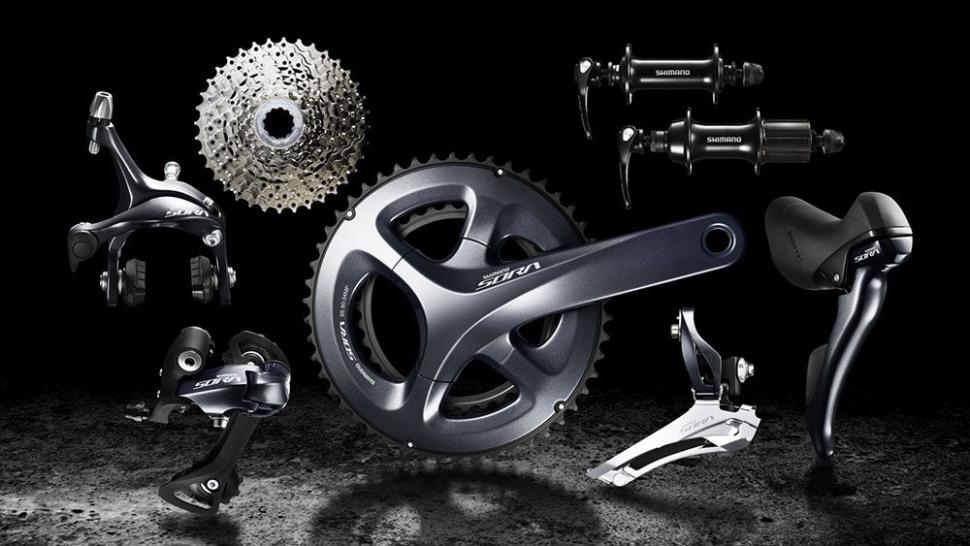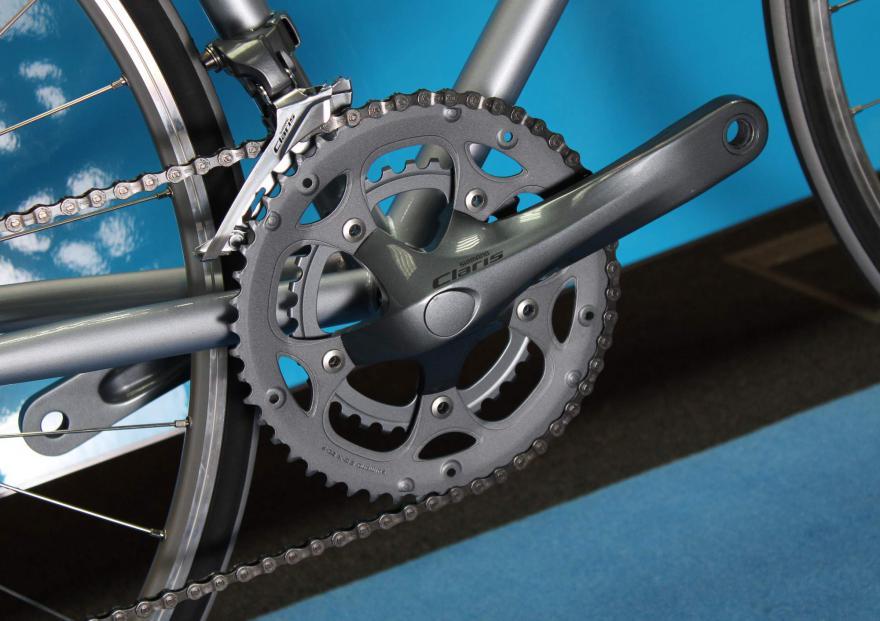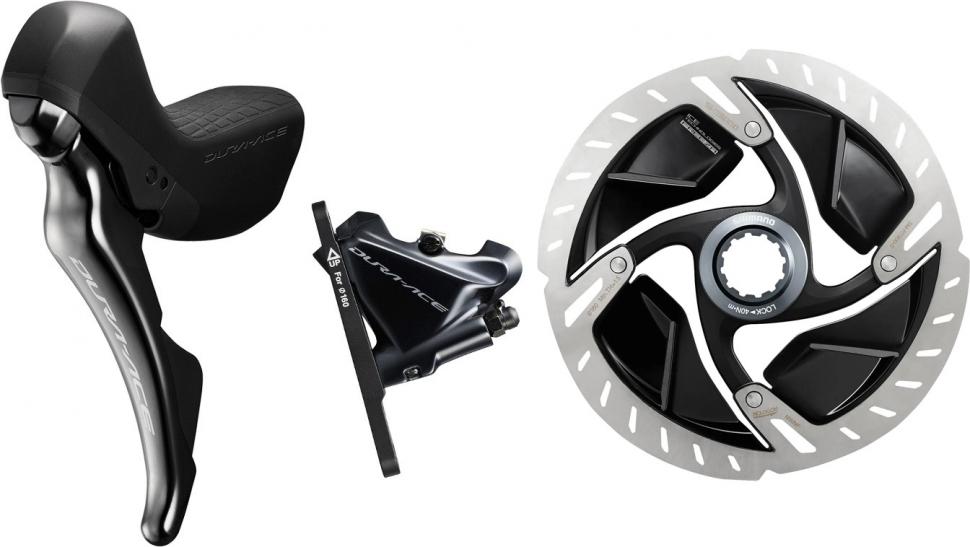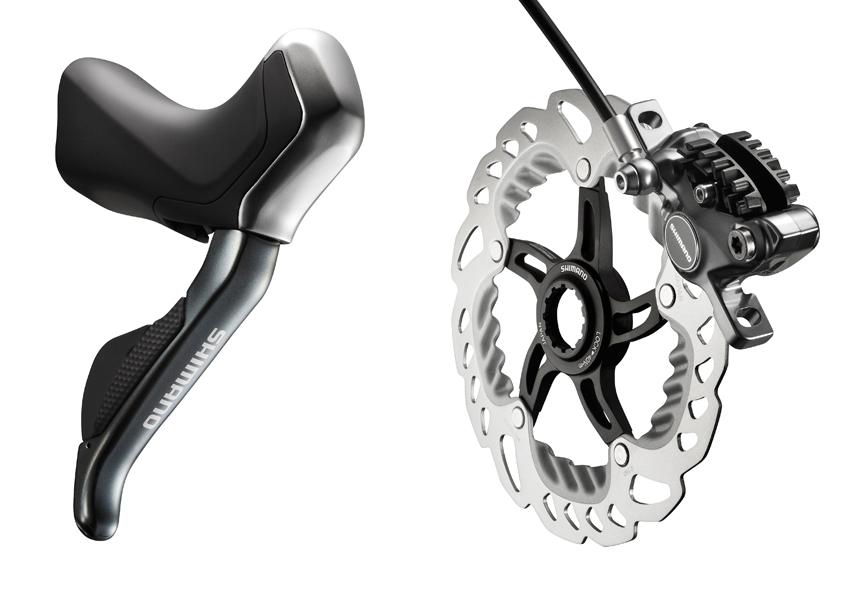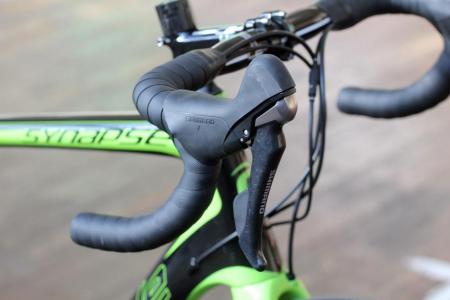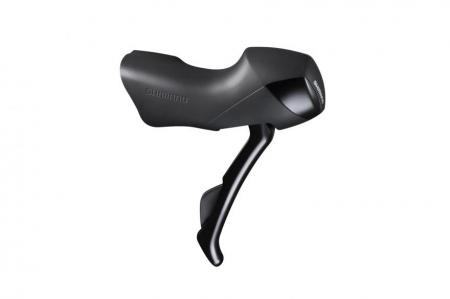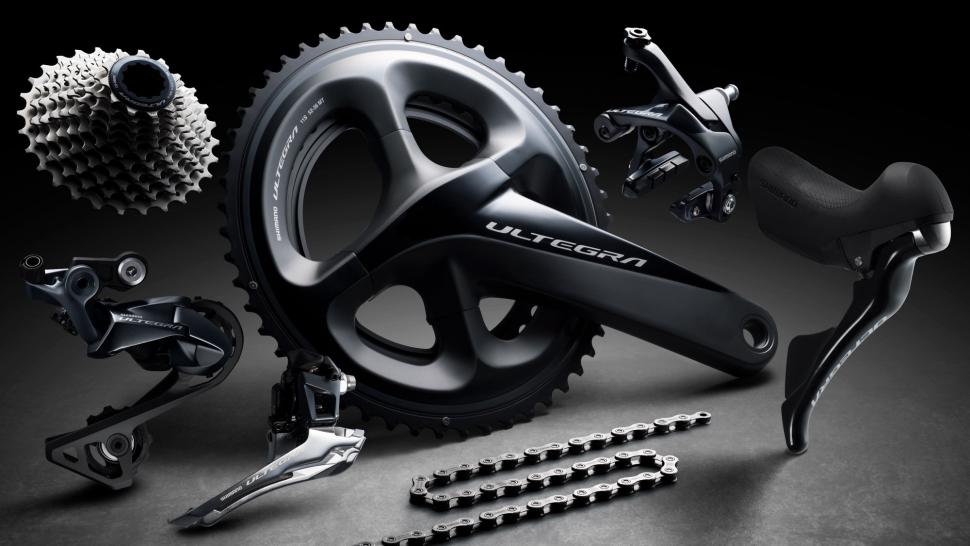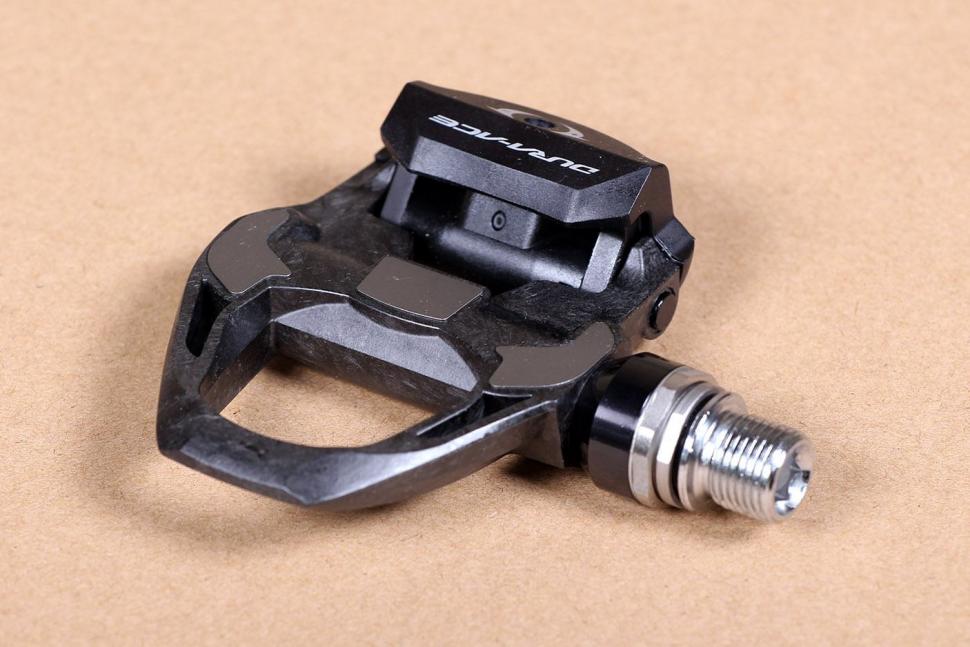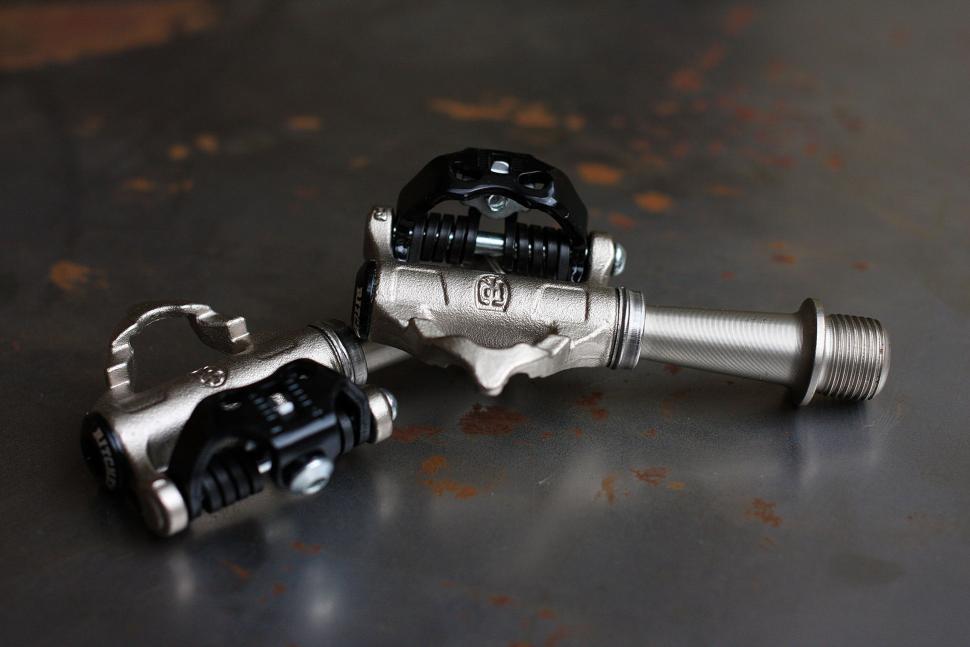A groupset is a collection of bike components designed to work together. These days it usually means the gears and brakes on your bike. The term once included the hubs and headset too, but threadless headsets knocked the traditional groupset makers — Shimano and Campagnolo — out of the market. Nevertheless, the groupset is where a lot of the money in a new bike goes.
Japanese company Shimano is the most popular groupset manufacturer with a range of groupsets at different prices. It’s constantly updating the groupsets too, with the newest features debuting first on its top-end groupset, Dura-Ace, before eventually filtering down through the range.
Whether you’re buying a new bike, or looking to build one from scratch, it’s good to know what your options are. The more expensive groupsets are lighter and usually offer smoother gear shifting and superior braking performance, and you get more gears and with the more expensive groupsets, 11-speed on Dura-Ace, Ultegra and 105, down to 8-speed on entry-level Claris.
Here’s an overview of the entire lineup, with the most expensive at the top of the list:
- Shimano Dura-Ace 9070 Di2
- Shimano Dura-Ace 9000
- Shimano Ultegra Di2
- Shimano Ultegra
- Shimano 105
- Shimano Tiagra
- Shimano Sora
- Shimano Claris
The range includes six mechanical groupsets, using cables to operate the front and rear derailleurs, and there are two electronic groupsets. First introduced in 2011, electronic groupsets have proved to be extremely popular, with precise gear changes, long battery life and good durability. Whether you choose mechanical or electronic comes down to budget and personal preference.
At the moment (early October), both the 2017 Dura-Ace 91XX and the previous 90XX components are listed by retailers, though it looks like we're still a few days off actually being able to buy the new parts. We've therefore covered both here.
>>Read more: Why you should switch to electronic shifting
Shimano Dura-Ace 9150 Di2
RRP: £3,040.82
Shimano's flagship component group gets a major facelift and some new options for 2017. The mechanical and Di2 electronic groups share the same chainset, brakes and other non-shifting components, but with Di2 you get switches on the brake levers, derailleurs with built-in motors and the battery, wiring and control box that ties it all together.
The major new feature of Di2 is Synchronized Shift, a technology borrowed from Shimano's mountain bike Di2 components. Rather than buttons controlling front and rear derailleurs independently, one pair of buttons moves up and down the gear ratios, making shifts at the front or rear derailleur, or both, as necessary.
Shimano says this is “designed to simplify gear choice and reduce decision making in racing situations.”
There are two modes. If you go for the Full Shimano Sychronized Shift, the front derailleur reacts based on the rear derailleur’s shift action. You don’t need to use two separate shifters, you just use one. Press one button and the gear will get harder to turn, press the other button and the gear will get easier. If that requires a front shift, the system will take care of that automatically; you don’t need to worry about it.
If you go for Semi Shimano Synchronized Shift mode: the rear derailleur reacts based on the front derailleur’s shift action, shifting to the next most appropriate rear gear when the rider makes a front shift.
A new junction box is not only very tidy — it can be hidden inside the end of the handlebar — it provides wireless ANT Private connectivity to third-party devices. The system also offers a Bluetooth connection to phones and tablets running Shimano's E-Tube software so you can program the shifting behaviour.
Buy if: You want the state of the Shimano art.
Read more: New Shimano Dura-Ace R9100: 5 key innovations
Shimano Dura-Ace 9100
RRP: £1,904.91
If your budget won't stretch to the electronic version of Dura-Ace, the mechanical version is by no means second best — it's still a superb ensemble. The 9100 group offers perhaps the widest range of options Shimano has ever offered in road bike components, including a power meter, hydraulic disc brakes, a wider gear range and an increased selection of wheels.
The 9100 group features new derailleurs too, using design features that originally appeared on Shimano's mountain bike parts to reduce the chance that the rear mech will get damaged in a crash. Just one rear derailleur will handle any gear system you choose, including the new 11-30 cassette.
Shimano's rival SRAM has offered power meters since it acquired Quarq in 2011. With the 9100 group Shimano adds a very tidy power meter to its collection. How tidy? You can see in the pic to the right that the electronics are barely visible:
The inclusion of hydraulic disc brakes in the Dura-Ace line shows how completely Shimano has embraced road bike discs. Previously Dura-Ace equipped bikes with discs had to use Shimano's non-series brakes and levers; now they match.
If you're using rim brakes, the 9100 Dura-Ace calipers have been subtly redesigned so they'll accommodate 28mm tyres.
Finally, there's a big range of wheels in the latest Dura-Ace line up. The new C40 and C60 wheels have 28mm wide carbon fibre rims that are 40mm and 60mm deep, respectively.
Buy if: You're racing or doing mega distances and you want the best mechanical shifting.
Read more: Shimano 9100 first ride review
Read more: Shimano reveals new top-end R9100 Dura-Ace groupset
Shimano Dura-Ace Di2 9070
RRP: £2,999.99
This is Shimano’s most expensive groupset. Shimano Dura-Ace Di2 has become hugely popular and most professional teams use it. It's favoured by many well-funded amateur racers and sportive cyclists too, or anyone who wants the best money can buy. The groupset uses the same chainset, chain, cassette, brakes and bottom bracket as regular Dura-Ace, but the shifters and front and rear derailleurs are different.
Dura-Ace Di2 uses a similar shifting design to mechanical, but instead of pushing two levers, you push two buttons positioned next to each other. If you want to move two or more sprockets at a time, rather than swinging the lever further like you do with a mechanical system, you just keep the button pressed down.
If you want, you can customise the shift function. Plug the groupset into a computer and you can configure the shift buttons in any way you want. You can personalise the speed of the shifting, the number of sprockets that will be shifted, and even control the rear derailleur with the left hand. An advantage of Di2 is the option of adding additional shifter pods, satellite shifters that can be fitted to the tops or the drops.
The latest Di2 groupset features an internal battery, which you can hide inside the seat post. Worried about it going flat? It’s good for a claimed 2,000km between charges. That’s lots of riding. Apart from charging the battery, there is very little to go wrong with Di2, and it’s actually really well suited to winter riding and long distance rides through demanding conditions.
>>Read our review of the Shimano Dura-Ace Di2 9070 11-speed gear system
Shimano Dura-Ace 9000
RRP: £1,499.99
Dura-Ace mechanical is still a very good groupset, so don’t overlook it too hastily. It’s probably the best ever mechanical groupset (SRAM and Campagnolo fans might disagree), with super slick gear shifts and really powerful brakes.
Dura-Ace was the first Shimano groupset to go to 11 sprockets, causing some controversy at the time, but widely accepted now. Shimano has evolved the ergonomics of the hoods (the rubber part at the top of the brake lever) over the years and this design has trickled down through the ranks.
Review: Shimano Dura-Ace 9000 groupset
Buy Dura-Ace if you want the lightest pro-level groupset
Shimano Ultegra 6800 and Ultegra Di2 6870
Shimano Ultegra 6800
RRP: £969.91
Shimano Ultegra 6800 Di2
RRP: £1,680.82
If you want high performance without the hefty price tag of Dura-Ace, then Ultegra is probably the pick of the range. Since the 6800 update, the gap between the two has been narrowed, and it shouldn’t be overlooked too quickly if you want high performance and decent weight components.
It’s a favourite with amateur racers because the weight penalty is minimal, especially if built onto a decent carbon fibre frame, and the performance is nearly identical. You still get the carbon fibre brake lever as well like you do on Dura-Ace, and the cranks, brakes and derailleurs share the same design as Dura-Ace.
Dura-Ace is really aimed at racing bikes, making Ultegra a more versatile groupset. With a range of chainring and cassette options, it can be fitted to all sorts of bikes, from racing cycles to touring and adventure bikes. From an 11-23t cassette and 53/39t chainset for the racers to an 11-32t cassette and 50/34t compact chainset for sportive riders, it covers a lot of uses.
The new chainset uses the same spider design so changing rings is easy, so you could easily swap rings from racing to riding in the mountains without removing the cranks. The rear derailleur comes in short- and mid-cage lengths and can work with up to a 32t sprocket on a wide-range cassette. Cassette options range from 11-23t right up to 11-32t, with plenty of options in the between the two extremes.
Ultegra is now available with a Di2 option as well and is Shimano’s most affordable Di2 groupset, and there is no 105 Di2 on the horizon at the moment. Like Dura-Ace, both Ultegra groupsets are 11-speed.
- Review: Shimano Ultegra 6800 groupset
- Shimano Ultegra Di2 6870 11-spd groupset
Buy Shimano Ultegra if you want performance without the price tag of Dura-Ace
Shimano 105 5800
RRP: £664.99
Shimano 105 probably used to get overlooked in favour of Ultegra, but the latest version brings it into line with the visual appearance first introduced on Dura-Ace. So now it’s a very good looking groupset, but more than that, it’s a stunning performance groupset for the money. It’s a bit heavier than Dura-Ace and Ultegra, but the performance runs both very close, with good shifting and braking.
105 also received an upgrade to 11-speed when the latest version was released in 2014. It was 10-speed previously. It’s heavier than Ultegra, but you have to be a weight weenie to worry about that. Incredibly good performance for the money, and with shifting performance so close to the performance of Ultegra, choosing between the two might simply come down to money.
You see a lot of entry-level and mid-range bikes specced with Shimano 105, it’s the workhorse of the Shimano groupset range, and features on bikes covering a really wide price band. Sometimes it gets mixed with other branded parts to meet key price points, but a full 105 groupset is definitely something to look for, as there really is no weak part of the groupset.
- Review: Shimano 105 5800 11-speed Groupset
Buy Shimano 105 if you want the most affordable 11-speed groupset
ShimanoTiagra 4700
RRP: £540.91
Shimano’s fourth-tier groupset was updated for 2016. The changes bring it the appearance of Shimano 105 above it, with the same four-arm crankset and new shifters, with the gear and brake cables hidden underneath the bar tape. As well as the drop-bar kit, Tiagra will be available with flat bar levers and shifters, so expect to see it on commuter and city bikes as well.
Tiagra retains the 10-speed configuration, though, and that could be a deciding factor if choosing between Tiagra and 105. There’s no 53/39t chainset option for Tiagra either. Shimano reckon that most people buying a Tiagra-equipped bike probably won’t be racing it and won’t need the really high gears. The 52/36t, 50/34t and 50/39/30t triple chainset options still provide plenty of range, and 52/36t is just fine for most racers.
- Shimano Tiagra 4700 first ride
Buy Shimano Tiagra if you want good value and performance, and don’t mind not having 11-speed, but for another £100 (less if you shop around) you can upgrade to 105...
Shimano Sora R3500
RRP: £417.91
Underneath Tiagra is Shimano’s Sora groupset, which has had a major facelift for 2017. It now matches the higher groups in the range visually, with its four-arm chainset, and a similar grey finish (though we can't be the only ones who wish for a shinier option). It’s a 9-speed groupset, but it’s still excellent for the money and does 90% of what the more expensive groupsets do; it just weighs a bit more.
You get proper Dual Control gear shifters, with the brake lever changing down the cassette and the smaller lever changing to a higher gear. That’s essentially the same system as used to be on Dura-Ace a few years ago. You have double and triple chainset options, and the rear derailleur will accommodate an 11-32t cassette along with a 50/34t compact chainset.
Other similarities with the more expensive groupsets include the Hollowtech 2 bottom bracket, with the bearings sitting outboard of the frame.
Buy Shimano Sora if you want performance and value
Shimano Claris 2400
- RRP: £306.69
Claris is Shimano’s most affordable road bike groupset and is what you can expect to see on sub-£500 road bikes. The most recent update to the groupset was in 2013, when it received the same Dual Control combined brake/gear levers as Sora above it, with the downshift behind the brake lever rather than a thumb button. Claris really does have the quality feel of the more expensive Shimano groupsets.
It’s an 8-speed groupset and is aimed at beginner and new cyclists, and so you have triple chainset (53/39/30), compact(50/34) and cyclocross (46/34) chainset options, along with an 11-32t cassette. Getting up climbs won’t be a problem with the lowest gearing available with Claris. The chainsets use the older Octalink bottom bracket standard.
- New Shimano Claris groupset in detail
- Review: Cube Peloton Claris (2015)
Buy Shimano Claris if you’re on a budget
Hydraulic disc brakes
We can't have a guide to Shimano groupsets and not mention the brakes. Shimano offers a choice of regular dual pivot or newer direct mount brake calipers, and also an increasing choice of disc brakes. As mentioned above, there are now dedicated Dura-Ace discs, and Shimano introduced a 105-level brake earlier in 2016, but the disc brakes you'll most often see on bikes at the moment are "non-series" so don’t come labelled with Dura-Ace or Ultegra. There are Di2 and mechanical gear shift options with the hydraulic reservoir integrated into the brake lever body.
- Shimano ST-R785 (Di2)
- Shimano ST-RS685 (mechanical)
- Shimano ST-RS505 (mechanical)
Dura-Ace Di2 R9170 and R9120 disc brakes
Prices
Shimano says these are its first discs designed specifically for road bikes, rather than being adapted from mountain bike brakes. At £450 per end (£500 for Di2) they're also the most expensive brakes Shimano has ever made. Like the R785 and RS685 brakes, below, they're available with 140mm and 160mm CenterLock rotors.
Disc brakes have numerous advantages over rim brakes: they're less affected by water; they're unaffected by rim damage and they provide finer control over braking power than is possible with rim brakes.
Hydraulic brakes also self-centre and automatically compensate for pad wear, neither of which you get with cables, and both of which are real benefits.
Buy if: You want Shimano's latest and best disc brakes — and you have deep pockets.
Shimano ST-R785
RRP: £499.99
Shimano’s first road-specific disc brake offers a genuine improvement in braking power and control. The system comprises brake calipers, disc rotors and brake levers, and you can combine with either Dura-Ace Di2 or Ultegra Di2 11-speed groupsets.
Shimano's road disc brake system has been designed for use with 140mm or 160mm rotors, with the idea being that users can choose the size to suit their weight and intended use. The rotors are designed to combat overheating with fins and grooves. They are CenterLock only, there's no 6-bolt option.
Buy if you want electronic shifting and hydraulic disc brakes
- Review: Shimano BR-R785 road hydraulic discs
Shimano ST-RS685
RRP: £624.99
But what if you don't want Di2 with your hydraulic disc brakes? Shimano was listening, and RS685 is the result. It offers mechanical gear shifting with hydraulic disc brakes. Shimano sees this as an Ultegra level groupset but as it’s 11-speed it’s compatible with Dura-Ace and 105.
ST-RS685 uses the same brake caliper as BR-RS785, it’s just the brake lever that is actually different. Shimano has included a mineral oil reservoir and brake system in the mechanical lever while managing to keep that lever compact. The lever features a 10mm reach adjustment to customise the fit for people with smaller or larger hand.
- First ride: Shimano ST-RS685 hydraulic disc brakes with mechanical shifters
Shimano ST-RS505
RRP: £425
- Shimano hydraulic discs trickle down to 105 level
Shimano has this year introduced a new 105 level hydraulic disc brake. The functionality is based on the RS685 hydraulic brakes with mechanical shifting, but ushers in a new ergonomically shaped hood design. To save weight, and keep the cost down, the brake levers are aluminium rather than carbon fibre. There's 10mm of reach adjustment so you can tune the lever to your hands.
Shimano has two level brake calipers to choose from, and they’re compatible with any of the brake levers. There’s BR-RS505 for 105, BR-RS805 for Ultegra/Dura-Ace. Both make use of the Flat Mount design, an emerging standard in the road disc bike market. It creates improved aesthetics as the calipers sit flush with the frame.
